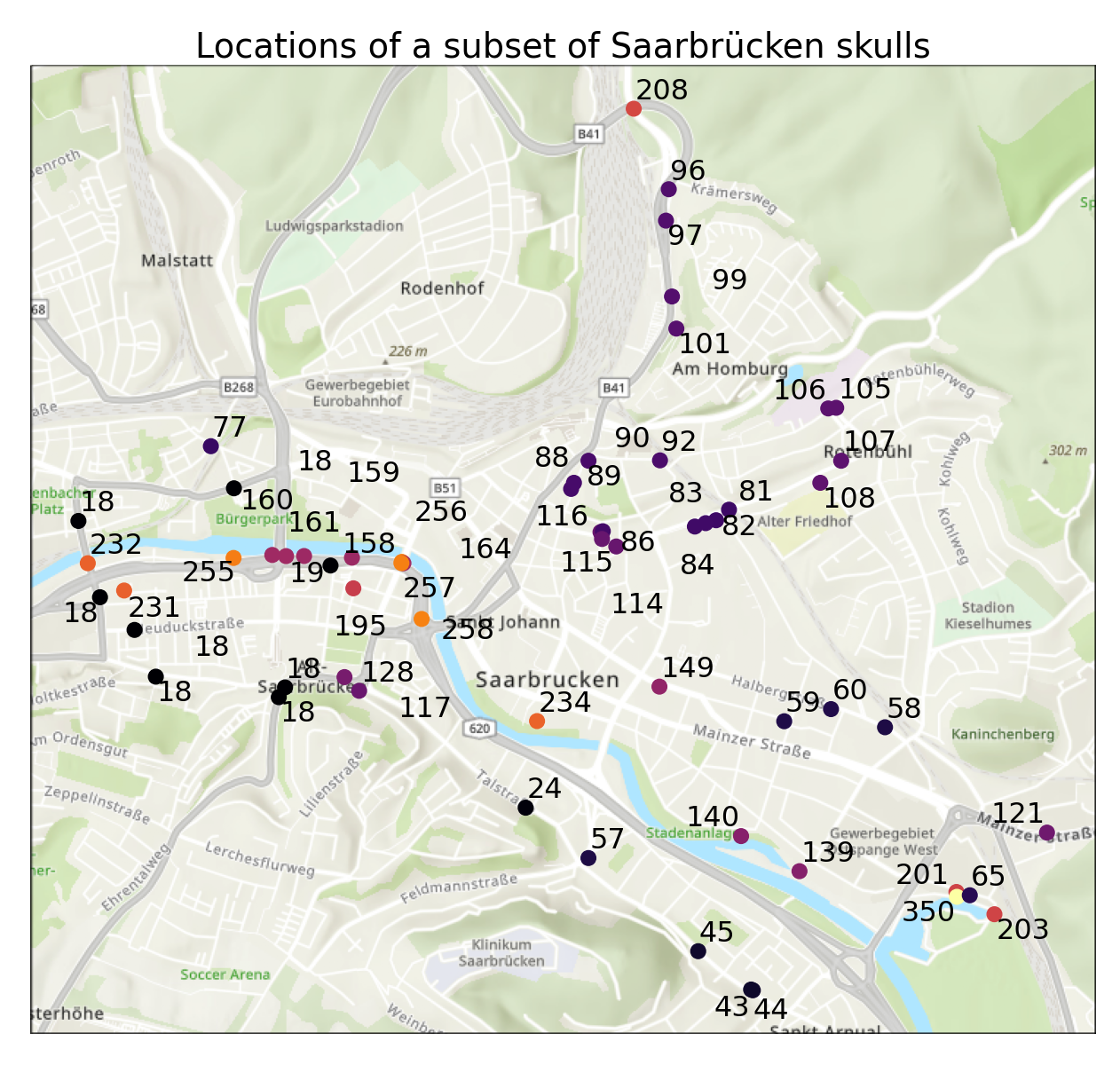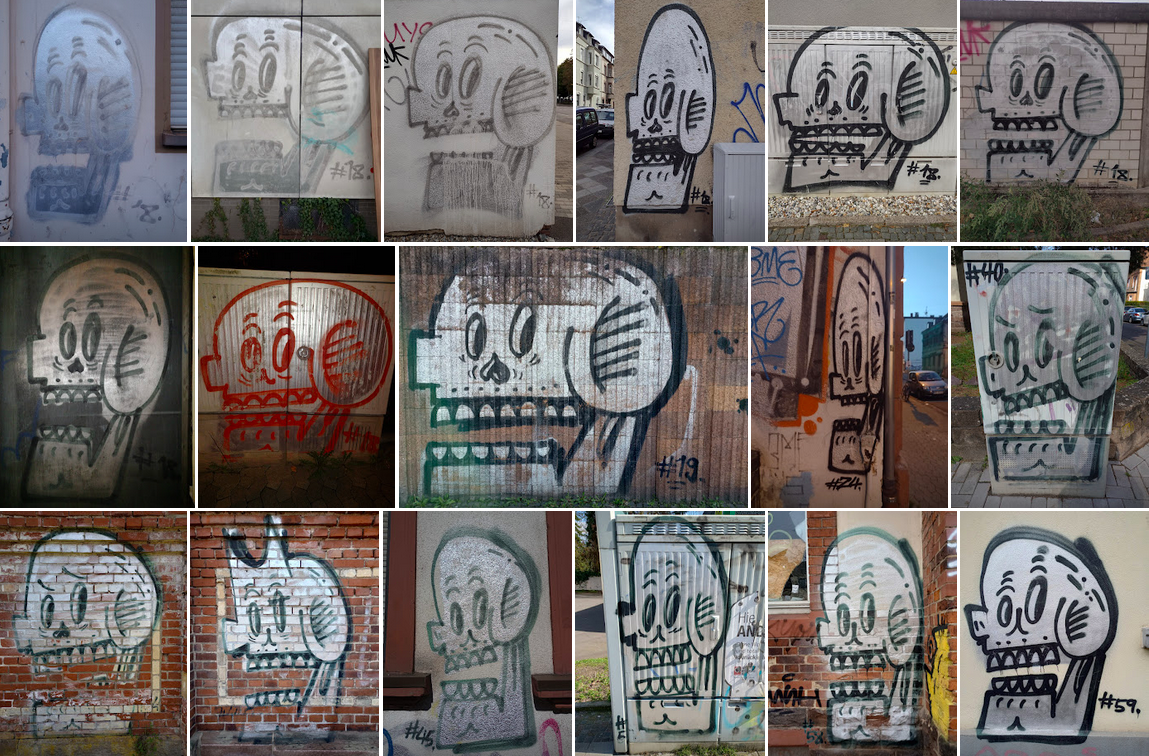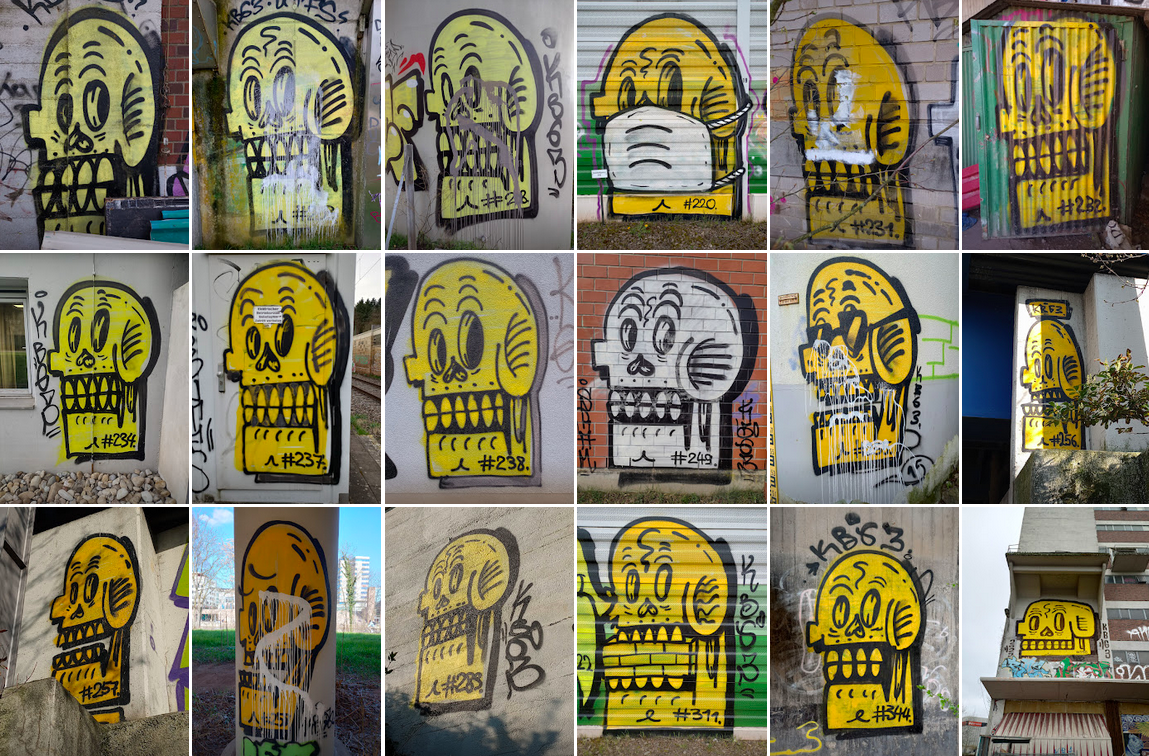Skull-spotting in Saarland
germany by Vagrant GautamMy latest hobby - collecting the KB63 crew's numbered skull graffiti in Saarland.
Most people who know me know that I love birding, but only people in Saarland know about my new hobby of collecting a special type of local graffiti: numbered skulls created by the KB63 graffiti crew. I started about a year ago and my official count is 101 skulls (plus another 15 to 20 I've marked to properly visit later), so this felt like a good milestone to brag blog about.


Skull-spotting seems to scratch the same itch as birding because there's a thing to collect and make lists of, and both hobbies make it easier for me to deepen my connection with places. Getting to know a city's regular bird visitors turns it from a place I sometimes walk through into a living, breathing home whose rhythms I know. Just as I now recognize the return of the screaming swifts as a temporal anchor heralding the spring, the skulls have become my geographical anchors as I've learned the layout of Saarbrücken. Telling me street names or store names is futile, but if you tell me your house is near that one skull with the really elongated head I will know exactly where you live. Since I found out that these skulls are spread out all across the (federal) state of Saarland, I've been venturing further out on my skull-hunting trips, to places I would have little reason to visit otherwise (like Luisenthal and Güdingen).
When I started systematically collecting pictures and locations of the skulls, I thought I could collect them all and I hypothesized that a plot of all the coordinates when connected would give me a much larger skull over Saarland. That theory was easily falsified when I had collected some data and made a preliminary plot. More importantly though, the process of data collection revealed several assumptions that turned out to be bad. My first setback was finding that not all skulls were numbered, unlike a typical connect-the-dots puzzle. I also found that several were numbered 18, meaning that numbered skulls weren't even uniquely numbered. And the worst blow to this project by far was when I realized that 3 skulls I'd previously collected had recently been painted over, i.e., I was never going to be able to get all of them because some might disappear before I ever even saw them.
Despite my flawed assumptions and no grand unifying pattern of skull graffiti, I've still learned some interesting things from the data:

-
Beyond falsifying my theory about the shape the coordinates would form, plotting skull coordinates on a map of Saarbrücken was also useful to confirm some anecdotal observations about their geographic distribution; I've found a lot of skulls along main roads and highways after spotting them on the go. I'm reluctant to say that the artists prefer to place skulls in these locations without actually asking them, because I can't be sure that my observation isn't just a result of selection bias (further away from home, I am more likely to travel on buses and trains than on foot).
-
Even though there don't seem to be any patterns that unify all the skulls, there are some pockets with progressions of consecutive numbers, e.g., skulls 80 to 92 seem clustered between the neigbourhoods of Sankt Johann and Rotenbühl, and the 18s all seem to be in Alt-Saarbrücken, close to the Betriebshof.
-
Anecdotally, although some skulls are placed in more visible areas, many others are tucked away and signalled with the word 'tut' spray painted in a more visible location. For instance, skull #260 was on the back of a billboard, making it impossible to see from the road or even the sidewalk, but it appeared close to a 'tut' spray painted onto the side of a shed that I could see from the bus.
-
Across locations, the artists seem to love using power boxes, cement and brick walls, and corrugated metal surfaces like garage doors and sheds. These observations are probably limited by survivorship bias because I have found a handful of skulls that were so faded from the weather that they were almost impossible to see. I suspect that over time the artists have developed preferences for different surfaces and materials, and that's also something I'd love to ask them about.
-
Assuming that numbers increase with time, there has been an evolution in the art style: older skulls are usually wider and white or silver, and they tend to have open jaws, noses shaped like inverted Vs, and numbers painted outside the skull. Newer skulls on the other hand are generally yellow and narrow, with a compact arrangement of numbers, closed jaws, noses shaped like inverted hearts, and more decorative squiggles. The newer skulls also seem to show more experimentation with other expressions and accessories - I've seen a worried skull, a skull with sunglasses, a skull eating what appears to be bricks, and a masked skull.


While I have learned a lot just from collecting data and talking to Saarlanders, I still have many unanswered questions that I would love to ask the artists if I should ever meet them:
- How did you start with skulls?
- Is the skull a specialty of one person in the group or are there multiple artists who create each one?
- What does "tut" mean in the context of your skulls?
- What's the process? How do you decide on a new location to graffiti? What time of day do you generally do it? How often do you do it?
- What is the history of the numbering of the skulls? Why are a few of them numbered #18? Why have you chosen not to number some?
- What materials do you use? And are there any reasons for the apparent changes in colour over time? E.g., it seems like you phased silver out in favour of white, and the more recent ones seem to mostly be yellow.
- Do you keep track of all of the ones you've done on a map or a list or anything?
- I've noticed that some of the skulls have paint splashed over them - why do you think that is? Are there people who dislike your skull graffiti or your group?
- I've been honked at while trying to get up close to photograph some of the skulls in slightly more dangerous locations (by highways, train tracks, etc.), and I assume you have gotten into trouble while creating the graffiti in the first place. Do you have any fun stories you can share?
- Do you have a favourite skull you've done?
- How long have you been doing this? What have you learned along the way?
- Would it be okay if I got a tattoo of one of the skulls?
If one of the artists is reading this, I would love to grab some beers - on me. As for everyone else, I hope that wherever you are, you're enjoying your local art and your local birds!
- Next post: Intersectional subgroup fairness is not intersectionality
- Previous post: Bureaucratic violence
- Back to the archive